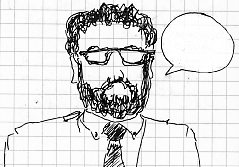Saturday, May 20, 2006
The Future's Historians

I post this morning not to decry Superman's dickishness, though the cover to Superman #293 (Nov. 1975) depicts a fine example of this that has, of course, been duly noted. (Isn't that Lois Lane pulling on his cape, for goodness' sake?)
No, this morning I'm posting because re-reading this particular issue of Superman's adventures actually provided me with food for thought about the historical profession, and how people in general tend to perceive and identify with the past.
For, joining the reader in a pulse-pounding exploration of Thirsty Thursday is young Joann Jaime, a historian from the 35th century!

Joann helpfully informs the reader that "we futuristic historians, though, don't just record history -- we relive it ..." Now this is the first paragraph of written text on the comic's first page, and already there's something worth reading twice.
Isn't the study of history supposed to deliver humanity from the futility of having to relive (and repeat the errors) of the past? Has the writer, Elliot S! Maggin, slipped in a sly, philosophical statement about the limitations of historical research in there? Sure, we've had loads of time to study the errors of the past, and where did it get us? Did the study of the First World War prevent the Second?
So, with their ability to go back in time, futuristic historians like Joann seem to have it all figured out. Except for ...

(Love that info-screen — Ms. Jaime is on the case!)
It's interesting (and comforting, in a way) to learn that even with their ability to go back and relive the past, the future's historians can't explain how every last thing happened. We're told that historians have been going back to this moment in time every five years in order map out the miracle which occurred on Thirsty Thursday. But no one has ever been able to crack it. And, I'm sorry to report, the estimable and well-prepared Joann fails in the attempt, as well.
The reason why Joann Jaime fails is both simple and profound. The future-travellers who flock to this miraculous and mysterious moment in time find themselves participants in the event, rather than objective observers and gatherers of information. Though they're duty bound not to interact unduly with the people they meet, they are nonetheless subject to the conditions affecting the individuals already living in the time-stream into which they've transported. This insight is one that the futuristic historians haven't fully conceptualized — hence the periodic (and futile) attempts to solve the mystery.
The plot centers upon a run-away chemical reaction which forces the populace to develop a suicidal abhorrence to water. Superman learns that the "antidote" to the exposure is to force the everyone to sleep for 24 hours. He effects this by using his heat vision to release large coulds of sleeping gas into the city. Of course, the gas incapacitates the time-travelling historians in the same way that it does the rest of the population, rendering them unable to discern exactly how Superman (or anyone else) saved the day.
This reads like a clever metaphor for historical research to me. Not so much the insight about a time-traveller becoming a participant, rather than an objective observer. What strikes closer to home is the knowledge that the limitations of evidence and human experience make it impossible for any historical researcher to ever provide a complete representation of the past she's examining. We're forced to recognize the difference between reliving the past and exploring it through research, scholarship, and writing. Rather than simulating time-travel into the historical periods that interest us, our goals must lie elsewhere.
The subtle distinction between living history, and examining and understanding it, is at the heart of Maggin's story. Thinking about the interplay between "reality," subjectivity, evidence, and the simulacra which scholarship allows us to produce brought to my mind Jorge Luis Borges' "On Exactitude in Science," (which is in his Collected Fictions, trans. by A. Hurley, (Penguin, 1998), p. 325. (The story follows in its entirety.)
...In that Empire, the Art of Cartography attained such Perfection that the Map of a single single Province occupied the entirety of a City, and the Map of the Empire, the entirety of a Province. In time, those Unconscionable Maps no longer satisfied, and the Cartographers Guilds struck a Map of the Empire whose size was that of the Empire, and which coincided point for point with it. The following Generations, who were not so fond of the Study of Cartography as their Forebears had been, saw that vast Map was Useless, and not without some Pitilessness was it, that they delivered it up to the Inclemencies of Sun and of Winters. In the Deserts of the West, still today, there are Tattered Ruins of that Map, inhabited by Animals and Beggars; in all the Land there is no other Relic left of the Disciplines of Geography. — Suárez Miranda, Viajes de Varones Prudentes, Libro IV, Cap. XLV, Lérida, 1658
